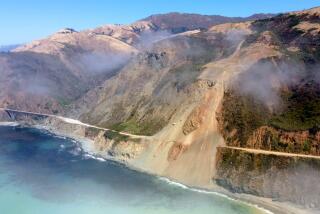Landslide is a mess -- and a boon
- Share via
SEATTLE — The owner of a fluff-and-fold laundry in a small western Oregon town couldn’t be happier that tons of mud, rocks, snow and fir trees sloughed off a hillside one day in January.
No one was hurt when the landslide took out the Union Pacific Railroad’s main track through the Cascades south of Eugene, but it has severed a key rail link between Los Angeles and Seattle. The slide spans 3,000 feet.
The railroad has dispatched about 200 workers to clear toppled old-growth trees, shore up the hill, and rebuild the tracks. Luckily for the local business, the crews take their mud- and silt-caked jeans and overalls to the 4-month-old laundry in nearby Oakridge.
“It’s been great for us,” said Rendilee Wortham, owner of Laundry Haven. She and her husband plug away 12 hours a day, seven days a week, cleaning the dirty garb.
Their small enterprise got lucky, as did many others in the quiet town, which is accustomed to outfitting summer-recreation enthusiasts.
The rail business, on the other hand, remains challenged. It will be late this month at the earliest before the rail line is restored, Union Pacific has said.
Meanwhile, 15 freight trains that used the line now detour through Bend, Ore., and Salt Lake City, causing delays of one to two days. Large freight movers in the Northwest report that delays in getting empty rail cars have held up shipments of some materials to California.
Amtrak’s Coast Starlight between Seattle and Los Angeles has been suspended, disrupting travel for about 1,400 daily passengers.
Amtrak restored a portion of the service in February between Los Angeles and Sacramento. On Friday, Amtrak said it would add bus service between Sacramento and Portland, with stops in the Oregon cities of Medford, Eugene and Salem. Amtrak Cascades service still runs between Eugene and Vancouver, Canada.
Amtrak expects to relaunch the Coast Starlight in May, said Amtrak spokeswoman Vernae Graham. “We’re all very hopeful,” she said.
“The slide is massive,” Graham said. “It’s unlike any slide we’ve seen in recent years.”
Union Pacific engineers were alerted to the Oregon mudslide when a signal indicated a section of track had been knocked out.
The size of the Jan. 19 slide on Coyote Mountain -- a remote area north of Chemult and about 15 miles east of Oakridge -- shocked engineers.
The railroad company estimates it covered 20 acres and was 200 feet deep -- a total of 2.3 million cubic yards. “When we started looking at it, we realized that it was huge,” said Zoe Richmond, a spokeswoman for Union Pacific in Oakland.
Complicating matters, about 700,000 board feet of old-growth timber fell, turning the track rebuilding effort into a logging as well as excavation operation.
“We had these huge old-growth trees to move out of the way before we could do anything else,” she said.
Helicopters clear stumps and fallen trees. More than 125 pieces of equipment, such as excavators and haul trucks, manipulate huge loads on the site. Working 12-hour shifts, crews have carted off 625 train-car loads of loose dirt and silt and have moved 211 train-car loads of logs. In turn, they bring in rocks to stabilize the zone.
Oakridge, a magnet for outdoor recreation enthusiasts in the summer, doesn’t seem to mind the influx of rail workers. Winter is normally a laid-back time. Not so this year.
“No vacancy” signs hang from motels. Restaurants open early and close late. Nearly every business has benefited from the slide, said Randy Dreiling, owner of Oregon Adventures mountain bike company and executive director of the Oakland-Westfir Area Chamber of Commerce.
Dreiling said he felt bad for the railroad (“they are losing millions and spending millions”), but he said “it couldn’t have happened at a better time for this little town.”
Not only are motels, vacation rentals and bed-and-breakfasts full, residents are even renting out extra bedrooms to repair crews.
“There’s no recession in Oakridge,” Dreiling said. “We’re lucky up here right now.”
--
More to Read
Sign up for The Wild
We’ll help you find the best places to hike, bike and run, as well as the perfect silent spots for meditation and yoga.
You may occasionally receive promotional content from the Los Angeles Times.






